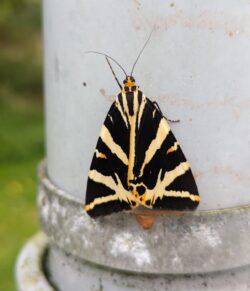It’s been a fascinating couple of weeks for our Grounds & Gardens team as they took part in their first ever Big Butterfly Count.
This annual event, run by Butterfly Conservation, invites people across the UK to spend 15 minutes observing and recording butterflies and moths in their local area over the course of a two-week survey period. For the team responsible for maintaining the College’s landscapes, it was an opportunity to combine their love for nature with a desire to contribute to crucial conservation efforts.
“The team recently took part in the Big Garden Birdwatch and we found it really interesting to spend time learning about the birds that live in our grounds. It felt like a natural step to take part in another citizen science project to educate ourselves a little about butterflies and discover which species are present on our site.” explains Kath, Gardens Team Leader at Churchill.
“Butterflies are sensitive to environmental changes making them excellent indicators of biodiversity and a healthy environment, and we wanted to see how our grounds were faring.”
The team now have a benchmark against which to test what they anecdotally believe has been an increase in butterflies across the site since the introduction of more long grassy areas. They plan to participate every year going forward to gather data that could potentially influence ongoing developments in the grounds.
The team carried out four separate counts on four different days in the long grassy areas of 68 and 70 Storey’s Way and the long grass along Madingley Road, spotting up to 13 different varieties in total. “There were particularly plentiful sightings of Gatekeepers and Meadow Browns in long grass areas, likely due to that particular habitat”, explains Kath “but we also saw Large Whites, Small Whites, and Peacock butterflies during our surveys. Some others were a Common Blue, Red Admirals, Marbled Whites, Speckled Wood and a Comma.” It was also noted that areas with a larger diversity of self-sown wildflower species yielded the highest diversity of sightings.
- Peacock
- Red Admiral
- Speckled Wood
The highlight of the count was spotting a Jersey Tiger moth on the greenhouse drainpipe, a beautiful moth with creamy white strips on its forewing and bold orange underwings. Although the jersey tiger moth is not endangered or threatened, it is extremely localised and so is considered somewhat rare in the UK. Unlike other moths, it has been unaffected by climate change and the general population trend for this species is on the rise.

Jersey Tiger Moth
Taking part in the count also sparked discussions among the team about future projects. They will be continuing to plant more native wildflower areas and hopefully this will encourage a greater diversity of butterfly species. “It’s good to think that small changes we make here could have an impact on the local butterfly population in the future,” Kath remarked.
Photo credit for butterfly images: Charlie Ison, Gardener, Churchill College



